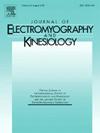上肢神经肌肉功能可区分盂唇修复和未修复的个体
IF 2.3
4区 医学
Q3 NEUROSCIENCES
引用次数: 0
摘要
本研究的目的是确定神经肌肉功能的常见测量方法是否能够区分以组别(盂肱唇修复术、未受伤对照组)表示的受伤状态。16名盂盂关节唇修复患者(24.1 ± 5.0岁,术后36.7 ± 33.3个月)和14名未受伤的对照组患者(23.8 ± 2.7岁)自愿参加了这项研究。我们测量了质量标准化肩关节外展和腕关节屈曲最大自主等长收缩力矩(牛顿米/千克)、腕屈肌运动神经元池兴奋性(霍夫曼反射)、双侧斜方肌上部、三角肌中部和腕屈肌的皮质神经元兴奋性(主动运动阈值 [%])。为了确定每种结果是否能区分损伤状态及其结果阈值,进行了接收者操作特征曲线分析。二元逻辑回归用于确定每种结果的分类准确性。我们的结果表明,肩关节外展扭力对称性(≤95.5%)和斜方肌上部的皮质脊髓兴奋性(≥41.0%)具有极佳的诊断效用。肩关节外展扭矩(≤0.71 牛米/公斤)和运动神经元池兴奋性(≤0.23)的诊断效用可接受。仅肩关节外展扭矩对称性是最强的指标,对损伤状态的分类准确率为 90.0 %(p < 0.01)。总体而言,对称性肩关节外展力量最能准确区分个人的损伤状况,这表明在该人群中进行双侧评估是有用的。本文章由计算机程序翻译,如有差异,请以英文原文为准。
Upper extremity neuromuscular function can distinguish between individuals with and without glenohumeral labral repair
The purpose of this study was to determine whether common measures of neuromuscular function could distinguish injury status indicated by group membership (glenohumeral labral repair, uninjured controls). 16 individuals with glenohumeral labral repair (24.1 ± 5.0 years, 36.7 ± 33.3 months after surgery) and 14 uninjured controls (23.8 ± 2.7 years) volunteered. We measured mass-normalized shoulder abduction and wrist flexion maximal voluntary isometric contraction torque (Nm/kg), motoneuron pool excitability of the flexor carpi radialis (Hoffmann reflex), corticospinal excitability of the upper trapezius, middle deltoid, and flexor carpi radialis (active motor threshold [%]) bilaterally. Receiver operator characteristic curve analyses were performed to determine if each outcome could distinguish injury status along with their outcome thresholds. Binary logistic regression was used to determine the accuracy of classification for each outcome. Our results suggest shoulder abduction torque symmetry (≤95.5 %) and corticospinal excitability for the upper trapezius (≥41.0 %) demonstrated excellent diagnostic utility. Shoulder abduction torque (≤0.71 Nm/kg) and motoneuron pool excitability (≤0.23) demonstrated acceptable diagnostic utility. Shoulder abduction torque symmetry alone was the strongest indicator, and classified injury status with 90.0 % accuracy (p < 0.01). Overall, symmetric shoulder abduction strength most accurately distinguished individuals’ injury status, suggesting the utility of bilateral assessment in this population.
求助全文
通过发布文献求助,成功后即可免费获取论文全文。
去求助
来源期刊
CiteScore
4.70
自引率
8.00%
发文量
70
审稿时长
74 days
期刊介绍:
Journal of Electromyography & Kinesiology is the primary source for outstanding original articles on the study of human movement from muscle contraction via its motor units and sensory system to integrated motion through mechanical and electrical detection techniques.
As the official publication of the International Society of Electrophysiology and Kinesiology, the journal is dedicated to publishing the best work in all areas of electromyography and kinesiology, including: control of movement, muscle fatigue, muscle and nerve properties, joint biomechanics and electrical stimulation. Applications in rehabilitation, sports & exercise, motion analysis, ergonomics, alternative & complimentary medicine, measures of human performance and technical articles on electromyographic signal processing are welcome.

 求助内容:
求助内容: 应助结果提醒方式:
应助结果提醒方式:


